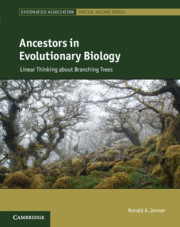Book contents
- Ancestors in Evolutionary Biology
- The Systematics Association Special Volume Series
- Ancestors in Evolutionary Biology
- Copyright page
- Dedication
- Contents
- Acknowledgments
- 1 A History of Narrative Phylogenetics
- 2 From Archetypes to Ancestors
- 3 The Emergence of Lineage Thinking
- 4 Ernst Haeckel’s Evolutionary Storytelling
- 5 The Epistemic Rise of Hypothetical Ancestors
- 6 Intuiting Evolution
- 7 Telling Straight Stories with Fossils
- 8 Seeing Animal Ancestors in Embryos
- 9 Ancestral Attractions and Phylogenetic Folklore
- 10 Narrative Shortcuts and Phylogenetic Faux Pas
- 11 Taxic Distortions of Lineage Thinking
- 12 Making Sense with Stories
- References
- Index
- Systematics Association Special Volumes
8 - Seeing Animal Ancestors in Embryos
Published online by Cambridge University Press: 08 July 2022
- Ancestors in Evolutionary Biology
- The Systematics Association Special Volume Series
- Ancestors in Evolutionary Biology
- Copyright page
- Dedication
- Contents
- Acknowledgments
- 1 A History of Narrative Phylogenetics
- 2 From Archetypes to Ancestors
- 3 The Emergence of Lineage Thinking
- 4 Ernst Haeckel’s Evolutionary Storytelling
- 5 The Epistemic Rise of Hypothetical Ancestors
- 6 Intuiting Evolution
- 7 Telling Straight Stories with Fossils
- 8 Seeing Animal Ancestors in Embryos
- 9 Ancestral Attractions and Phylogenetic Folklore
- 10 Narrative Shortcuts and Phylogenetic Faux Pas
- 11 Taxic Distortions of Lineage Thinking
- 12 Making Sense with Stories
- References
- Index
- Systematics Association Special Volumes
Summary
In this chapter I examine one of the earliest debates about animal body plan evolution. Ernst Haeckel, E. Ray Lankester, Francis Maitland Balfour, Elie Metschnikoff, and Otto Bütschli were the main participants in an international debate about the origins of animals that was triggered by the publication of Haeckel’s Gastraea theory in the 1870s. Each author proposed a different hypothetical animal ancestor, which, with the exception of Bütschli’s, were the products of recapitulationist reasoning. Each of these hypothetical creatures stood at the beginning of a unique scenario with a distinctive explanatory texture, and many of them can still be found in the pages of zoology textbooks today. This late-nineteenth-century clash of scenarios is representative of narrative phylogenetic debates generally. It shows how unique evolutionary stories are produced by authors wielding their personal evolutionary intuitions in the context of unequal attention to available evidence. Unsurprisingly, disagreements quickly became entrenched as dogma, but strikingly, several of these early scenarios, as well as their descendants, continue to inform current debates in the primary literature today.
Keywords
- Type
- Chapter
- Information
- Ancestors in Evolutionary BiologyLinear Thinking about Branching Trees, pp. 217 - 241Publisher: Cambridge University PressPrint publication year: 2022

